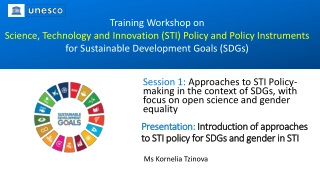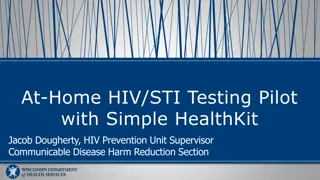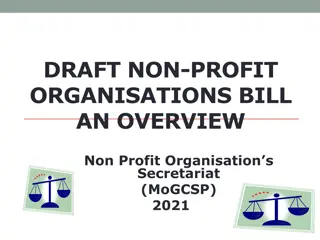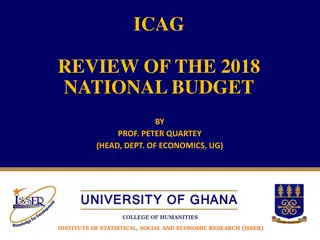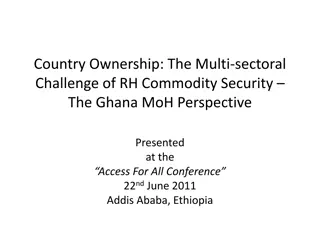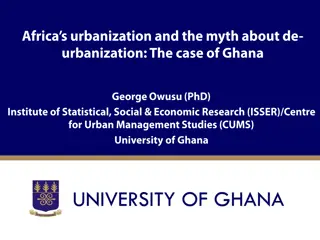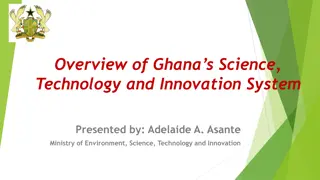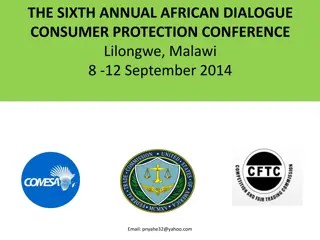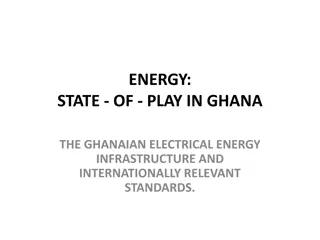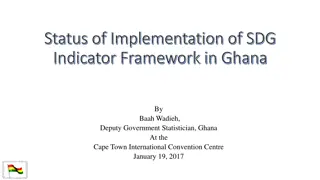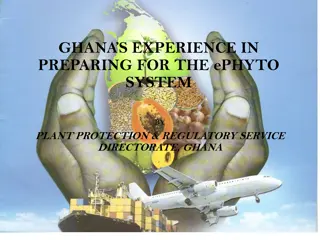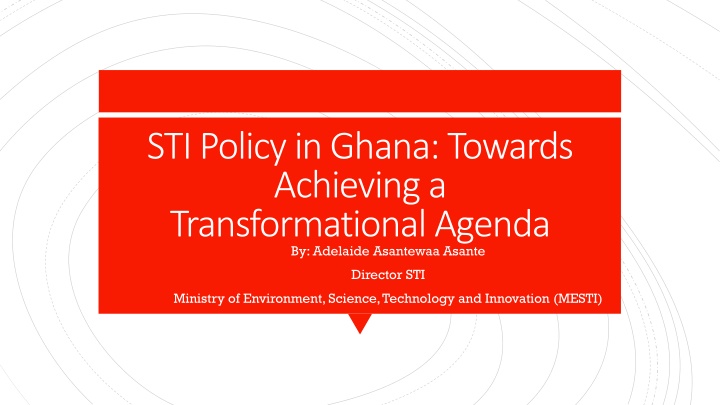
STI Policy in Ghana: Towards a Transformational Agenda
The necessity of an STI policy in Ghana for national development through a comprehensive presentation covering policy frameworks, development progress, and economic indicators. The analysis includes political stability, economic performance, STI indicators, and a SWOT analysis of Ghana's STI system."
Download Presentation

Please find below an Image/Link to download the presentation.
The content on the website is provided AS IS for your information and personal use only. It may not be sold, licensed, or shared on other websites without obtaining consent from the author. If you encounter any issues during the download, it is possible that the publisher has removed the file from their server.
You are allowed to download the files provided on this website for personal or commercial use, subject to the condition that they are used lawfully. All files are the property of their respective owners.
The content on the website is provided AS IS for your information and personal use only. It may not be sold, licensed, or shared on other websites without obtaining consent from the author.
E N D
Presentation Transcript
STI Policy in Ghana: Towards Achieving a Transformational Agenda By: Adelaide Asantewaa Asante Director STI Ministry of Environment, Science, Technology and Innovation (MESTI)
Why do we need an STI Policy National Development Policy Frameworks Presentation Outline STI Policy Development in Ghana Conclusion
Why Ghana Needs an STI Policy?
3/15/2025 4 Political stability indicators Fragile States Index- 65.9 (Ranking 110 and in the warning category) (2019 Freedom For Peace (FFP) Ranking) Governance Index- 65.0 (8thout of 54) (Mo Ibrahim Foundation s 2017 IIAG) Corruption Perceptions Index- 41 out 100score (Transparency International, 2018)
3/15/2025 Economic Performance Indicators Economic Performance Indicators Macroeconomic Indicators - 1. GDP Per Capita USD 1,648.3 (2017, Estimate, IMF) - Unemployment Rate -6.7%( Dec 2018, Trading Economics) - Debt To GDP Ratio 57% - 62% (Dec 2018 - Date, MoF) Overseas Development Assistance Share In Gross National Investment 4.9% (World Bank, 2015) Poverty And Inequality Indicators 24.2% National Average rate (GSS, 2013) Human Development Index 0.592 (Rank 139, UNDP, 2017, Medium Human Development Category)
Linking STI Indicators (Global Index)and Economic Linking STI Indicators (Global Index)and Economic Indicators Indicators 3/15/2025 6 Indicator Definition Indicator Definition Ghana Ghana South Africa South Africa South Korea South Korea R & D Expenditure (% GDP), 2017 0.3% 0.3% 0.8% 4.2% (Ranking 5th) Knowledge Index (Worldbank, 2017) 39.0 39.0 44.6 62.5 Global Innovation Index (WIPO, 2017) 24.52 (Ranking 107) 24.52 (Ranking 107) 35.8 (Ranking 57th) 57.7 (Ranking 11th) High Tech Exports (Knoema, 2017) USD 39Million Million(Ranking USD 39Million Million(Ranking 80 80th th) ) USD 1.8Billion (ranking 40th) USD 72 Billion (Ranking 8th) High Tech Export as a % of Manufactured Products (WorldBank , 2017) 4.24 4.24 4.64 14.18 GDP (WorldBank, 2017) USD 47Billion USD 47Billion USD 348Billion USD 1.5 Trillion
3/15/2025 7 SWOT Analysis of Ghana s STI System SWOT Analysis of Ghana s STI System Strength Weakness - - - - Existing National STI Policy and Development Plan Several public research institutions and Universities Commitment of Government to STI Development Potential development of key economic areas such as extractive industry, agricultural and ICT. Political stability and commitment of President in using STI as a mechanism for development Substantial mass of STI Human resources (scientists and engineers) Existence of Several technology support and regulatory agencies. Bilateral FDI Agreements on STI increasing as well as country s participation in several international programmes Existence of PPP Policy - - Weak STI advisory system Weak linkage of STI policy to National Development Agendas (i.e; Long Term Development Plan, Government Coordinated Priority Programme (2017-2024) and National Medium Term Plan (2017-2021)) Disconnect in STI Policy and other national sectoral policies and implementation plans Weak Implementation framework of STI Policy Weak coordination and Harmonization of STI programmes Lack of funding for National STI programmes R & D institutions under-resources Weak of networking system for STI service providers Utmost utilization of high-quality man-powers Limited Commercialization of Research Outputs Inadequate STI infrastructure Economy rely on traditional Export Poor Linkages between private sector and R & D institutions Financial Institutions not links with R & D and technology development programs - - - - - - - - - - - - - - - - -
3/15/2025 8 SWOT SWOT Analysis of Ghana s STI System Analysis of Ghana s STI System Opportunities Threats - The establishment of efficient system of education specialized in STEM The establishment of specialized STI R & D institutions for priority economic sectors Enhance linkages between R & D institutions and Industry More competitive environment to facilitate innovations and attracts Foreign Direct Investments as well as mobilize resources for implementation of STI policies and programmes Increase funding for R & D through the establishment of a statutory fund for STI Promote entrepreneurship for the youth and create jobs Improving existing STI infrastructure Improve the implementation of national priority policies and programmes through STI Connect STI strategies with all sectoral policies in the long term - - - Regional and international competitiveness Poor administrative and management practices Business as usual attitude from other policy makers (science for science and not for development) Predominantly service based economy Increasing phenomena of brain drain of science and engineering graduate Few oriented and less target scientific research activities still exists and can t be implemented in laboratories Less capabilities of firms (SMEs) to absorb transferred technologies and a few developed networks amongst STI actors Less linkages between FDI and National STI system to facilitate knowledge absorption Low level of technology patents in the STI system Campaign promises vices medium to long term national development plans - - - - - - - - - - - - - - -
National Development Policy Frameworks in Ghana
10 Draft National Long Term Development Plan (30 Years) Current National Development Strategy Framework CPESDP (2017-2024) National Medium Term Development Plan (2017-2021)
11 Goals of the Draft LTDP Strengthens Ghana s role in international affairs Build well-planned and safe communities whilst protecting the environment 5 Strategic Goals of the Long Term Development Plan Build efficient, effective and dynamic institutions for national development Create industrialized, inclusive and resilient economy Build Equitable Health and Prosperous Society
12 Goals of the CPESDP (2017-2024) 4 Strategic Goals of the Coordinated Programme for Economic and Social Development Policies (CPESDP): (i) build a prosperous country; (ii) create opportunities for all Ghanaians; Goals of the CPESDP (iii) safeguarding the natural environment and ensuring a resilient built environment; (iv) maintaining a stable, united and safe country.
Revitalizing the economy; Transforming agriculture and industry; 5 Priority Interventions of the CPESDP Strengthening social protection and inclusion; Revamping economic and social infrastructure; and Reforming public service delivery institutions
Economic Development Social Development Policies and Programmes of the CPESDP Environmental, Infrastructure and Human Settlements Governance, Corruption and Public Accountability Strengthening Ghana s Role in International Affairs Ghana and International Development Frameworks
15 The Coordinated Programme for Economic and Social Development Policies SDGs Goal 1: Build a prosperous country; Goals: 1, 2, 8, 9, 12, 10, 14, 17 Aligning the CPESDP to the SDGs Goal 2: Create opportunities for all Ghanaians Goals: 1, 2, 3, 4, 5. 8, 9, 10, 12, 14 Goal 3: Safeguarding the natural environment and resilient built environment Goals: 1, 3, 6, 7, 9, 11, 12, 13, 14, 15, ensuring a Goal 4: Maintaining a stable, united and safe country Goals: 1, 3, 8, 10, 16, 17
3/15/2025 16 The CPESDP Seeks to transform the economy by promoting the effective application of science, technology and innovation Linking the Goal of the STI Policy to CPESDP Goal of STI Policy- to harness the national STI capacities to achieve the national goal of industrial growth, rural development, poverty reduction and sustainable environmental management.
STI Policy Development in Ghana
Draft National S & T Policy, 2000 Context of STI policymaking in Ghana National STI Policy 2010 National STI Development Plan 2011-2015 (17 programmes and 84 Projects)- 5% implementation Evolution of STI Policy in Ghana since 2000 Draft National STI Policy, 2017 - STI agenda/strategies for all sectors of the economy Ghana s STI strategies have been continuously enshrined in important international agendas such as - AU Agenda 2030 - ECOWAS Policy S&T.
Evolution of STI Policy in Ghana since 2000 Focus on strengthening the National STI system by creating conditions for socio- technical system change STI Policy 2017 integrates STI into national development strategies in all sectors of the economy ST&I Policy 2010 ST&I underpinned enhancement of competitiveness and industrialisation Draft S&T Policy 2000 Institutionalizatio n of government support for S&T for socio- economic development Progressing towards a bigger picture of addressing societal and developmental challenges of Ghana developing strategies towards achieving the goals and targets in the National Development Agenda
Key directions of Ghanas science and technology policies since 2000 and 2017 Analysis of STI Policies, 2010 20 Policy Vision and goal Objectives Strategies National STI Policy, To fully integrate application of STI into national development strategy for poverty reduction, competitiveness of enterprises, sustainable environmental management and industrial growth. i. facilitate mastering of scientific and technological capabilities; - Sector Specific Strategies outlined - R & D Regulations dominant - Not Aligned with National Development Plans (2010- 2020) ii. provide the framework for inter- institutional efforts in developing STI and iii.create the conditions for the improvement of scientific and technological infrastructure for research and development and innovation.
Key directions of Ghanas science and technology policies since 2000 and 2017 Analysis of STI Policies, 2010 21 Policy Vision and goal Objectives Strategies STI Policy 2017 (2017- 2027) The vision is to develop to become a high income country which fully applies and integrates STI into national development strategies. This positions the country to harness the nation s total science and technology capacity to achieve national objectives i. facilitate mastering of scientific and technological capabilities; - Ministry Specific Strategies outlined National Systems of Innovation and Entrepreneurship Dominant Limited alignment with CPESDP ii. provide a framework for inter-institutional collaborations in developing STI programmes in all sectors of the economy to meet the basic needs of the society; - iii. create the conditions for the improvement of scientific and technological infrastructure for research and development and innovation; - iv. ensure that STI supports Ghana s trade and export drive for greater competitiveness; v. promote a science, technology and innovation culture in the wider society.
National STI System Policy Framework & Enabling Environment Education & Research System Industry Players Policy Makers in all Sectors led by MESTI & MOE R&D Policies including STI Policies Large Scale Firms Professional Education & Training Medium Scale enterprises Higher Education & Research Research & Development Governance & Regulation Micro & Small Scale enterprises Public & Private Research Institutions Infrastructural Support Innovation and Business Development Support Services incl. ICT and Transport, Financial Services Providers, donors, IPR support providers among others
3/15/2025 23 Funding Sources: 1. Government- 70% (from consolidated fund and caters mainly salaries and capital investments) Financing STI Policy Implementation in Ghana 2. Donor constitutes 20% of the funding (caters mainly for research activities) 3. Internally Generated Funds -10% - caters for administrative cost Establishment of the National Research Fund is on-going
3/15/2025 24 Strengthen the role of STI in the implementation of CPSEDP Identify the weakness/challenges of the National STI system and help address it Reviewing and Finalizing the Current STI Policy Guide the implementation of sectoral policies Provide STI roadmap for achieving the SDGs Strengthen the national data gathering and synthesizing system for monitoring and evaluating the achieving the SDG indicators
Ghanas political and economic indicators are relatively low National STI Indicators provides the bases for developing an STI Policy that aims to strengthen the STI ecosystem Current National Development Policy Framework only provide for short to medium development. There is the need to complete the Long-term Development Plan Conclusion There is the need to strengthen STI policy formulation, implementation, evaluation and governance in line with the Current National Development Policy Frameworks while contributing to addressing the sustainable Development Goals (SDGs).

